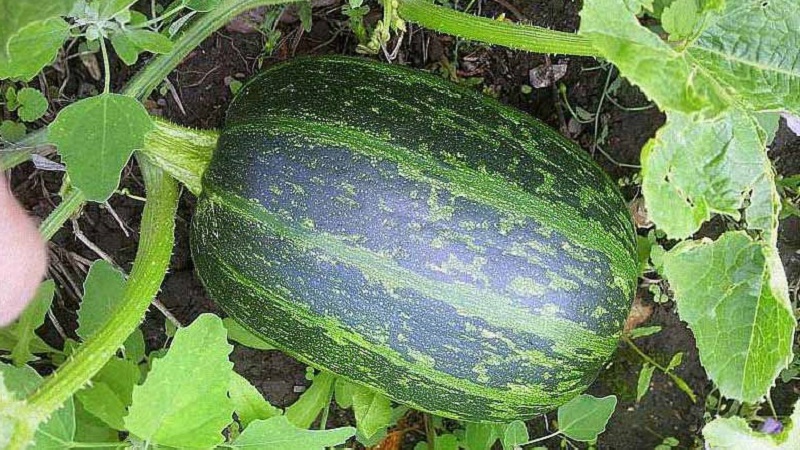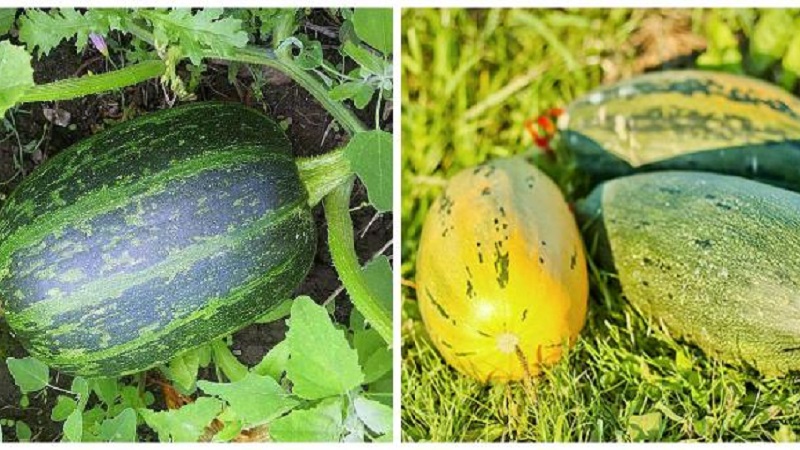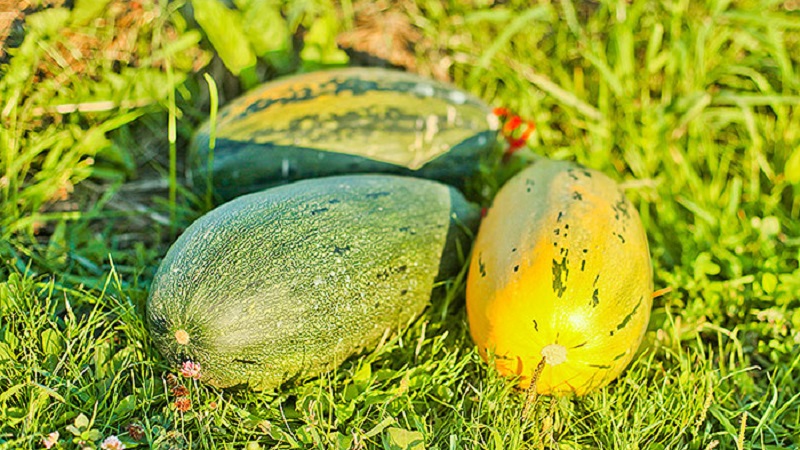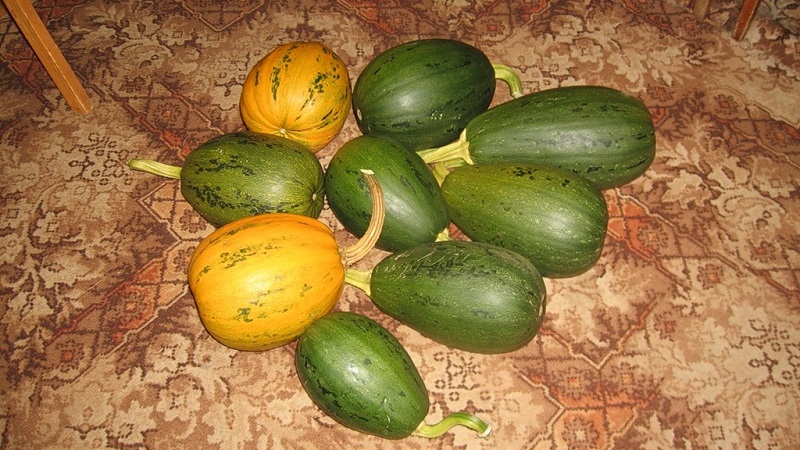How to grow a pumpkin "Gribovskaya bush": the secrets of agricultural technology
People have been growing pumpkins for 5 thousand years. During this time, hundreds of varieties, varieties and subspecies were created. The time-tested variety Gribovskaya bush is popular among gardeners due to its excellent pulp taste, high yield, unpretentious care and long-term storage of fruits.
The content of the article
Description of the variety
In 1964, a variety of bush culture was bred by Soviet breeders - Gribovskaya bush. The variety is recommended for cultivation in all regions of Russia.

Subspecies 189
Gribovskaya bush 189 - one of the oldest varieties of culture known among vegetable growers... Subspecies 189 is grown in the North-West region, the Urals and Siberia. Cultivated in personal plots, in the fields.
Early ripe variety: 86–98 days pass from germination to harvest.
For reference.Later, in 1972, another related variety was bred - the large-fruited Gribovskaya winter.
Distinctive features
Subspecies 189 - delicious and unpretentious pumpkin... Plants love warmth, light, fertile soil, are resistant to pests and diseases. The bushes themselves are powerful, but not climbing, compact. The leaves are large.
Sowing in open ground is carried out in early May., start growing seedlings 2-3 weeks before picking to a permanent place.
Fruit characteristics and yield
Gribovskaya bush pumpkin has large fruits: from 3 to 5 kg. In shape, they resemble zucchini, oblong, narrowed at the stalk. The surface is smooth or slightly ribbed, with hard bark. The color of mature pumpkins is light orange with dark green stripes.
The pulp is firm, sweet, contains many seeds, and is universal in cooking. Fruits contain 5 times more beta-carotene than carrots.
The crop is fruitful: from 1 m2 get up to 8 kg (30-40 t / ha).
How to grow
The agricultural technology of the variety is practically the same from growing other pumpkin varieties.
About other pumpkin varieties:
We grow a mid-season pumpkin "Guitar"
Planting with seeds and seedlings
The cultivation method is chosen depending on the climate: by seeds for the beds or seedlings. In cold regions, the seedling method is preferable. Planting pattern - 60x60 cm.
Growing seedlings:
- Seeds are disinfected with a weak solution of manganese to protect future sprouts from diseases.
- Choose a warm lit place with an air temperature of about + 20 ... + 25 ° C.
- Seeds are planted in individual containers or peat pots, which are half filled with a soil mixture of humus, peat and turf soil (2: 1: 1). Top covered with the same substrate, but with the addition of 10-15 g of ash and mullein infusion.
- The soil is moistened, covered with a film to create a greenhouse effect and retain the necessary moisture.
- Seedlings are watered in moderation, fed twice with mineral fertilizers.
- A week before the pick, the plants are tempered: they are taken out into fresh air, gradually increasing the time to the length of daylight hours.
- They are planted in open ground when warm weather settles (late May - early June).

Before sowing, planting material is prepared immediately on the beds:
- The seeds are heated for several days in the oven or near the battery.
- In a saline solution (1 teaspoon of salt per 1 tbsp. Of water), the specimens are checked for unsuitability.Floated grains are thrown away, the rest are washed.
- Then the seeds are germinated: they are laid out in damp gauze and placed in a warm place until the seedlings appear.
Sowing is performed when the soil temperature to a depth of 10 cm warms up to + 12 ... + 15 ° С... They choose sheltered from the wind, well-lit areas where potatoes, onions, legumes used to grow.
The land itself has been dug up since autumn, remove weeds, apply fertilizers (5 kg of humus, 30 g of superphosphate, 15 g of potassium chloride for each m2). If the soil is acidic, add chalk or dolomite flour. Peat and sand will improve the structure of the soil.
Before planting, the beds are loosened again, cleaned of weeds, add 20 g of ammonium nitrate per 1 m2... The seeds are deepened by 5–8 cm, the soil is moistened. The distance between the rows is at least 1 m. At first, the culture is germinated under the covering material.
Care
The pumpkin is watered regularly with warm water, at least 2 times a week (if the summer is hot, the frequency of irrigation is increased up to 4 times). Nitrogen fertilizing improves crop development. During the formation of fruits, phosphorus-potassium fertilizers are used.

When the soil is depleted, do the following:
- 10 days after planting, a solution of 1 liter of manure per bucket of water or 10 g of nitrophoska per 10 liters of liquid is introduced into the soil;
- when fruiting, use the same composition.
Fertilize vegetables 3-4 times per season... Instead of manure, you can use dung, herbal infusion.
The bushes of the mushroom pumpkin are pinchedso that the nutrients go to the growth of the fruit. Excess ovaries are removed as soon as they appear. Leave 2-3 ovaries. They loosen the soil after each watering for better oxygen supply to the roots, do it carefully so as not to damage the plants.
Features of cultivation and possible difficulties
Correct landing site - one of the main points of cultivation. The site should not be shaded. Greenhouses are built in regions with cold climates.
Although the culture needs regular watering, they are reduced to the formation of ovaries, otherwise the leaves will become fleshy, and not future fruits. Watered only with warm, settled water to avoid root rot and increase the shelf life of vegetables.
During the period of fruit ripening, watering is stopped. This will make the flesh sweeter.
Read also:
Growing tips
Summer residents a little hot water is poured into the holes before planting the seeds for warming up the soil and its disinfection.

When growing pumpkin seedlings, attention is paid to the air temperature: before emergence, the optimal values are +20 ° C during the day and +16 ° C at night. Over the next 6 days, the temperature is reduced to +15 ° C and +12 ° C, respectively, and then returned to its original characteristics. This will prevent the seedlings from pulling out. The seedlings themselves are not watered, but sprayed.
For better sunshine with the onset of fruit ripening, excess green leaves are removed from the plants. To protect the culture from frost, plastic containers (5 liters) with a cut bottom are placed in the wells.
Diseases and pests
Gribovskaya bush is relatively resistant to rot, but often suffers from powdery mildew and bacteriosis:
Bacteriosis
It appears as dark green spots between leaf veins... On the underside, the plates are oily. After a while, the spots darken, the dried fragments crumble, holes appear on the leaves. The affected areas of the bushes are removed.
Powdery mildew
Round white spots appear on the leaves, stems are affected, plants wither. To combat the disease, the culture is sprayed with sulfurous agents.
White rot
The aerial parts are covered with dark spots, mucus... Fruiting bushes die first. Sick areas are removed, the bushes are treated with copper sulfate.

Root rot
Roots turn brownish-gray, crack... The lower leaves turn yellow, the pumpkin stops developing.As a preventive measure, waterlogging of the soil is avoided, with excess liquid, dry soil is poured.
Diseases manifest in damp weather and with cold watering... Weeding and removing weeds prevent fungi from growing.
Pests
Melon aphids and spider mites are the main pests of culture... To combat them, use a tincture of garlic, colloidal sulfur and baking soda or special preparations.
Harvesting and application of the crop
 Gribovskaya bush 189 is harvested 80-90 days after planting... Ripe fruits are orange in color with a green stem, which has dried and looks like a cork. Cut vegetables together with the stalk, leaving a long tail.
Gribovskaya bush 189 is harvested 80-90 days after planting... Ripe fruits are orange in color with a green stem, which has dried and looks like a cork. Cut vegetables together with the stalk, leaving a long tail.
After harvest, the crop is stored in a warm, dry room. (about +10 ° C), it is possible in the sun. With high humidity, the fruits will not be stored for more than 2 months.
Special racks are made in the vegetable cellar... The pumpkins are laid with their tails up, not far from each other, but not close. The fruits are periodically examined and those that have begun to rot are thrown away. To extend the shelf life, damaged areas of the bark are lubricated with an antiseptic and sealed with a plaster.
Use vegetables for fresh consumption, addition to various dishes, dietary food.
Advantages and disadvantages of the variety
Benefits of Mushroom Bush Pumpkin:
- the possibility of long-term storage;
- relative resistance to fruit rot;
- suitable for medical and dietary food;
- pleasant taste of pulp with a high sugar content;
- unpretentiousness to weather conditions;
- compactness of bushes;
- high productivity.
As such culture has no flaws.
Farmers reviews
Vegetable growers note the good taste of the fruit, their possibility of using in cooking, unpretentiousness of culture in care and resistance to weather conditions:
 Ekaterina, Chelyabinsk region: “I have been growing this variety for a long time. Since childhood, I remember how he grew up with my grandmother in the garden. Gribovskaya bush is unpretentious in care and perfectly takes root in the climate of Chelyabinsk. I land when the ground warms up well. I cultivate outdoors, not in a greenhouse. I like stew and jam from Mushroom pumpkin ".
Ekaterina, Chelyabinsk region: “I have been growing this variety for a long time. Since childhood, I remember how he grew up with my grandmother in the garden. Gribovskaya bush is unpretentious in care and perfectly takes root in the climate of Chelyabinsk. I land when the ground warms up well. I cultivate outdoors, not in a greenhouse. I like stew and jam from Mushroom pumpkin ".
Tatiana, Volgograd: “I liked the pictures of the fruits and their description, which prompted me to buy the variety. There are 11 seeds in a bag, but only 2. I planted in June. The scourges have grown powerful. From 2 bushes, the harvest was 5 fruits. Two large, 5-6 kg each, and three medium-sized. The pulp is very sweet, but, unfortunately, a little dry. The pumpkin made an excellent porridge, homogeneous and without fibers ".
Sergey, Nizhny Novgorod: “Gribovskaya bush pumpkin is remembered from childhood, its pulp was juicy and sweet. When I saw the seeds in the store, I bought one packet. There are 4 seeds in it, one was damaged, 3 bushes of seedlings grew from the remaining others. I planted a pumpkin in the shade and rarely appeared in the country. Judging by all the norms and rules of crop care, the harvest could not have been expected. To my surprise, in autumn I found 6 pumpkins weighing 2 to 3 kg in the grass. They were kept at home until December, and when cut, the pulp was sweet, but not as juicy as in childhood. ".
Conclusion
Gribovskaya bush 189 is one of the best pumpkin varieties. It is distinguished by its unpretentiousness, immunity to major diseases, and a high yield of large juicy fruits. Due to the beneficial properties of the culture and its low calorie content, it is used in cooking, added to medical and dietary diets.
Fruits are stored for a long time without loss of taste and marketability.